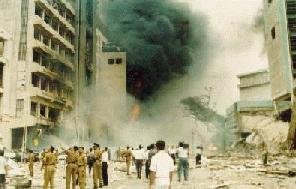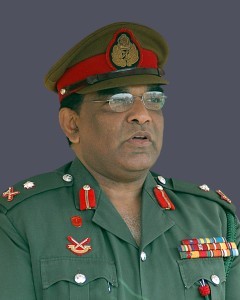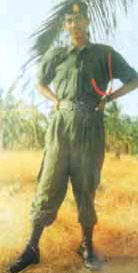
The Central Bank bombing was one of the deadliest attacks carried out by the Liberation Tigers of Tamil Eelam (LTTE) during the separatist civil war in Sri Lanka between the government and the Tamil Tigers.

Lieutenant General Parami Sugandika Bandara Kulatunga, RSP, VSV, USP was a senior Sri Lanka Army officer. He was serving as the Deputy Chief of Staff of the Sri Lanka Army and its third highest-ranking officer at the time of his assassination. On the morning of 26 June, he was killed by a Tamil Tiger suicide bomber who drove an explosives laden motorbike into his staff car as it was driving to a military base at Pannipitiya near Colombo.

Field Marshal Gardihewa Sarath Chandralal Fonseka, RWP, RSP, VSV, USP, MP, commonly known as Sarath Fonseka, is a Sri Lankan military leader and a member of the parliament. He was the eighteenth Commander of Sri Lankan Army, and under his command the Sri Lankan Army ended the 26-year Sri Lankan Civil War in 2009, defeating the Terrorist group, Liberation Tigers of Tamil Eelam; he thereafter briefly served as the Chief of Defence Staff. After retiring from the Army with the rank of General, he entered politics as the common opposition candidate in the 2010 presidential election contesting against President Mahinda Rajapaksa.

Colonel Tuan Nizam Muthaliff, RWP, MI was a Sri Lanka Army officer and intelligence officer who, while serving as the commanding officer, 1 Military Intelligence Corps, was assassinated by the Liberation Tigers of Tamil Eelam during the ceasefire and peace process.

The following tables present the military ranks and insignia of the Sri Lanka Army. The ranks are similar to the British army officer ranks and the other ranks.

The Second Battle of Elephant Pass, was a battle fought in April 2000 for the control of the Sri Lankan military base in Elephant Pass, Jaffna.

Major General Janaka Perera, RWP, RSP, VSV, USP, VSP, rcds, psc, CR was a Sri Lankan General and politician. He served as the Chief of Staff of the Sri Lanka Army and is considered one of the most distinguished generals in Sri Lankan history. After retiring from the army he served as a Sri Lankan High Commissioner to Australia and Ambassador to Indonesia. He was the opposition leader of the North Central Provincial Council until he and his wife were killed on 6 October 2008 by a suicide bomber. The LTTE have been blamed for the bombing by Sri Lankan president Mahinda Rajapaksa.
Operation Balavegaya was a combined military operation launched by the Sri Lankan military in Jaffna, the largest amphibious assault in its history. Operation Balavegaya was launched in response to the siege of Elephant Pass by the LTTE. It is believed that Operation Balavegaya was the largest and most successful military operation of the Sri Lankan military until Operation Riviresa in 1995.

Velayuthapillai Baheerathakumar was a leading member of the Liberation Tigers of Tamil Eelam (LTTE), a separatist Tamil militant organisation in Sri Lanka. He played a leading role in the LTTE's military victories in the Vanni during Eelam War III, including Mullaitivu (1996), Kilinochchi (1998), Oddusuddan (1999) and Elephant Pass (2000). He was killed at the Battle of Ananthapuram in the last days of the Sri Lankan Civil War.
A bra bomb is a bomb worn by women suicide bombers. Hiding the explosives in a bra instead of a vest allows for the women to show their midriffs when searched. In 2007 a Tamil Tiger suicide bomber had explosives hidden in her bra. She blew herself up outside the office of a Tamil minister.

Lance Corporal W.I.M Seneviratne PWV, SLLI was a Sri Lankan soldier. After joining the Sri Lanka Army in 1987, Seneviratne served during the Sri Lankan Civil War. On July 4, 1996, while providing security to visiting Minister Nimal Siripala de Silva in the northern city of Jaffna, Seneviratne sacrificed his life to thwart a Tamil Tiger suicide bomber from assassinating Minister de Silva. He was posthumously awarded the Parama Weera Vibhushanaya, the highest military decoration awarded for gallantry in Sri Lanka.
There were war crimes and crimes against humanity that were committed by the Sri Lankan military and the rebel Liberation Tigers of Tamil Eelam during the Sri Lankan Civil War, particularly during the final months of the Eelam War IV phase in 2009. The war crimes include attacks on civilians and civilian buildings by both sides; executions of combatants and prisoners by both sides; enforced disappearances by the Sri Lankan military and paramilitary groups backed by them; acute shortages of food, medicine, and clean water for civilians trapped in the war zone; and child recruitment by the Tamil Tigers.
The White Flag incident is the massacre of surrendering leaders of the Liberation Tigers of Tamil Eelam and their families by the Sri Lankan Army on 18 May 2009 in Mullivaikal, Mullaitivu, Vanni, Sri Lanka. The LTTE's Political Wing leader, Balasingham Nadesan and Pulidevan agreed to surrender and contacted the United Nations, the governments of Norway, United Kingdom, United States and the International Committee of the Red Cross. They were given assurance by Mahinda Rajapaksa, the Prime Minister of Sri Lanka, and told to surrender at a particular place by Basil Rajapakse. LTTE's request for a third party witness to oversee the surrender was not granted by the Sri Lankan government. The LTTE surrendered to the 58 Division carrying White flags and were reportedly shot dead. Sarath Fonseka, then the Sri Lankan Army Chief stated that they had been shot dead on the orders of Gotabhaya Rajapaksa to Shavendra Silva, Commander of the 58 Division. Balachandran Prabhakaran, Nadesan's son, was also killed after surrendering along with his bodyguards. a UN Panel states the LTTE leaders intended to surrender. The Sri Lankan government has denied any accusations of wrongdoing.
Dissanayake Mudiyanselage Sugath Chandrasiri Bandara, PWV was a Sri Lanka Army soldier. He served with the army's elite Special Forces Regiment during Eelam War IV, the final stage of the Sri Lankan Civil War. Chandrasiri Bandara received the Parama Weera Vibhushanaya, Sri Lanka's highest military award for gallantry, for thwarting a suicide attack by the Liberation Tigers of Tamil Eelam against the army at the cost of his own life.
Major General Ananda Sri Sisira Kumara Hamangoda, RWP, RSP, USP was a senior Sri Lanka Army officer, who was the former brigade commander of the 51-2 Brigade based in Jaffna, when he was killed by a LTTE female suicide bomber.
The following lists notable events that occurred during 2016 in Sri Lanka.

The Old Army Headquarters refers to the former military headquarters complex of the Sri Lanka Army. Situated next to Galle Face Green and Baladaksha Mawatha, the complex bordered the Beira Lake and had its main entrance at the Slave Island end of Baladaksha Mawatha, Colombo 3. The complex also included the Ministry of Defence buildings, located close to the Galle Face terminus of Baladaksha Mawatha. Apart from operational and administrative offices, it contained the centers of several regiments and corps of the Sri Lanka Army, as well as the Colombo Military Hospital and the army sports grounds.








